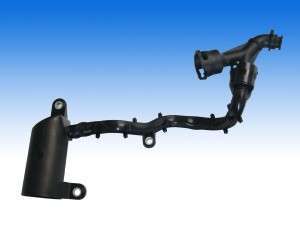A brand new molding process has been developed by Engel in cooperation with two partner companies Hummel-Formen and KVT Bielefeld. That collaboration sets the path for a new kind of process integration. The “joinmelt” process supports hot gas welding directly in the mold. Besides cost savings, it is said that the new process also improves part quality and functional safety.
 Oil lines and reservoirs are typical examples for hollow composite parts which are conventionally produced using a multi-stage process. In the first stage, the two part halves are injection molded and then, in a second process step outside of the molding machine, they are welded together. This multi-stage process usually requires concessions to part quality. The commonly used vibration welding can lead to flashes along the welding seam. Ultra small particles, so-called “flitter,” may appear and peel away, leading to the damage of further functional parts. Using the hot gas welding process would allow a clean and homogenous welding seam, but this process requires absolute plane-parallel joining areas which injection molded parts do not always offer. There is usually a certain degree of warpage during the cooling phase and ejection of the part.
Oil lines and reservoirs are typical examples for hollow composite parts which are conventionally produced using a multi-stage process. In the first stage, the two part halves are injection molded and then, in a second process step outside of the molding machine, they are welded together. This multi-stage process usually requires concessions to part quality. The commonly used vibration welding can lead to flashes along the welding seam. Ultra small particles, so-called “flitter,” may appear and peel away, leading to the damage of further functional parts. Using the hot gas welding process would allow a clean and homogenous welding seam, but this process requires absolute plane-parallel joining areas which injection molded parts do not always offer. There is usually a certain degree of warpage during the cooling phase and ejection of the part.
The “jointmelt” process combines everything in one: injection molding is followed by the welding process, inside the molding machine, without the need to remove the two halves of the part as an intermediate step. This solution, for which a patent is pending, promises potential savings, especially in the automotive industry. It removes the need for additional welding equipment, and part removal and re-insertion are no longer needed, as the finished product can removed directly out of the mold.
Besides the savings potential achievable due to the integration of two manufacturing steps previously performed in sequence, the new process also helps to improve the quality and functional safety of the parts. The fact that both product halves remain fixed in the mold during the welding process avoids issues with warping, and considerably reduces the time to market. The process creates a clean and thin weld which is particularly strong and achieves a superior quality to welds created by legacy techniques with respect to bursting pressure.
According to the company, this new technology is suitable for all thermoplastic materials. The process developers also see potential for the processing of glass fiber reinforced polyamides as fluid distributing parts for use in engine compartments.



